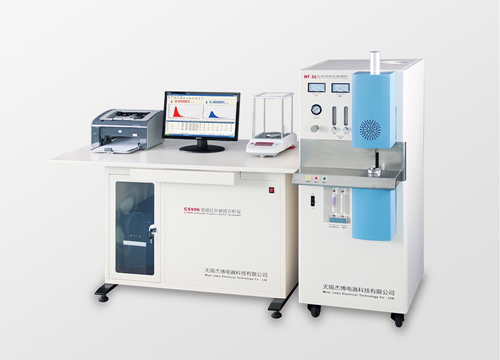Application of Infrared Carbon and Sulfur Analyzer in Cast Iron Manufacturing
Carbon and sulfur are important elements affecting the quality of automotive cast iron castings, and their contents are relatively high. Accurate and rapid determination is required in production. In this paper, a domestic CS996 Infrared Carbon and Sulfur Analyzer was used to try, and satisfactory results were obtained.

1 Experimental part
1. 1 instruments and reagents
CS996 infrared carbon and sulfur analyzer.
Caustic soda asbestos: particle size 0.297mm; anhydrous magnesium perchlorate: particle size φ 0. 297mm; ceramic crucible: φ 25mm ×
25mm; tungsten particles: particle size is 20 ~ 40 mesh.
1.2 Experimental methods
Take a ceramic crucible that has been burned at 1300 ℃ and place it on an analytical balance. After peeling, weigh 0.2g sample. After the quality display is stable, input 0.5g tungsten particles, then raise the crucible into the high frequency furnace , Press the analysis key, the instrument automatically completes the analysis, and displays the analysis parameters, release curve, measurement results, and prints randomly.
2. Results and discussion
In order to determine the analysis conditions that affect the analysis results, two high and low cast iron standard samples were selected, and the orthogonal test L16 (45)
Perform to select and determine the best analysis conditions.
2. 1 oxygen flow
Carbon and sulfur in the sample are converted into CO2, and the conversion rate of SO2 needs to be increased under high temperature and oxygen-rich conditions. test
It is shown that when the oxygen flow rate is <1.2 L / min, the analysis result of carbon is high, and the analysis result of sulfur is low. When the oxygen flow rate is> 2L / min, the repeatability of the analysis results becomes worse. When the oxygen flow rate is about 1.5 L / min, the analysis results are stable.
2.2 Infrared detection is a dynamic measurement of a certain constant-speed analysis airflow, and small changes in its flow directly affect the analysis result. The test shows that when the analysis of the cast iron sample is performed and the analysis gas flow rate is> 3.6L / min, the waveform of the carbon-sulfur release curve becomes narrower due to the accelerated flow rate and the integrated area decreases, resulting in a lower result. When the analysis gas flow is less than 3L / min, the waveform of the carbon-sulfur release curve becomes wider due to the slowed flow rate, and the integrated area increases, resulting in a higher result. When the analysis gas flow is 3.2 L / min, the result is stable.
2.3 Adding amount of tungsten particles
The test proves that the amount of tungsten particles has a greater impact on the analysis results. When the amount of tungsten particles added is small, the carbon release curve is widened and tailed, and the result is high; the sulfur release curve is narrowed, and the result is low. When the amount of tungsten particles added is large, the carbon and sulfur release curve is normal, the analysis blank is increased, and the result is high. At the same time, it is easy to cause slag splashing and damage the combustion pipe. When the amount of tungsten particles is in the range of 1.5g to 1.8g, the results are stable.
2.4 Weighing of sample
Tests have shown that sample weighing affects high-frequency combustion and infrared detection to varying degrees. When the sample weight is> 0.3g, the sample volume is large, the combustion is incomplete, and the analysis result is unstable. When the sample weighs <0. 100g, the concentration of the measured gas is correspondingly low, the measured infrared radiation signal is small, and the analysis accuracy is reduced. The test proves that when the sample weighs 0.2g, the sample burns completely, and the analysis sensitivity and accuracy are high.
2.5 Analysis time
The test shows that the pre-oxygenation time is 15s, the analysis time of carbon is 35s, and the analysis time of sulfur is 35s, which can meet the needs of the analysis of cast iron samples.
2. 6 Instrument improvements
The carbon content in cast iron is high, and the samples and fluxes generate more dust after combustion. The combustion tube and filter screen need to be cleaned once for every 10 samples analyzed. The analysis before the furnace brings great trouble. For this reason, the manufacturer installs a filter at the exit of the furnace head of the instrument analysis gas pipeline to intercept the dust in the analysis airflow in the filter, eradicating the problem of dust contamination of the pipeline.
3. Sample analysis
Through testing, the best analysis conditions of cast iron samples were selected and determined. Operate according to the analytical method.
Standard samples of cast iron and samples in production were analyzed.
This method uses domestic CS996-type infrared carbon and sulfur analyzer to determine the carbon and sulfur content in cast iron.
